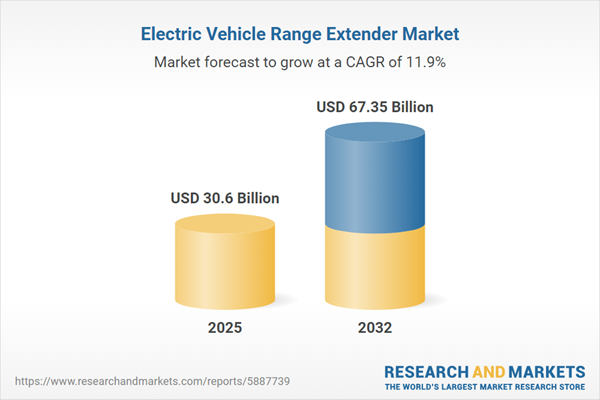Speak directly to the analyst to clarify any post sales queries you may have.
The electric vehicle range extender market is at a critical turning point, as regulatory shifts, infrastructure demands, and technological progress drive organizations to adapt strategic priorities. Senior decision-makers now face heightened pressure to ensure both agility and supply chain resilience in a challenging environment.
Market Snapshot: Electric Vehicle Range Extender Market
The electric vehicle range extender market is projected to expand from USD 27.37 billion in 2024 to USD 30.60 billion in 2025, and is expected to reach USD 67.35 billion by 2032. Growth is closely linked to increased adoption of electric vehicles and continued advancements in powertrain technologies. Regulatory focus on sustainability and investment in charging infrastructure are fueling shifts in competition. Both established companies and new entrants are refining technical standards, building new partnerships, and strengthening capabilities to serve a broader spectrum of transportation segments. Market leaders are reevaluating strategic approaches to fit the evolving compliance landscape and proactively addressing risk exposure.
Scope & Segmentation of the Electric Vehicle Range Extender Market
- Extender Types: Battery-only range extenders support compliance in zero-emission zones. Hydrogen fuel cell systems, including proton exchange membrane and solid oxide types, offer greater operational versatility. Internal combustion solutions continue to serve regions reliant on liquid fuels.
- Fuel Types: Solutions are compatible with CNG, diesel, gasoline, and hydrogen fuels, supporting fleets operating across varying infrastructure and regulatory backgrounds.
- Power Output Ranges: Range extender offerings address urban routes with low-capacity options, daily commute needs with mid-range systems, and commercial transportation through high-output configurations.
- Vehicle Categories: Applications span passenger vehicles, two-wheelers, light commercial and heavy commercial vehicles, addressing public, private, and industrial transport needs.
- Application Modalities: Both OEM-integrated and retrofit solutions are available, empowering fleet operators to modernize assets or deploy new vehicles with the latest technologies.
- Sales Channels: Distribution approaches include direct engagement with OEMs and specialist aftermarket channels tailored for enterprise and regional fleet buyers, offering specific aftersales support.
- Regions Covered: Market strategies are adjusted to infrastructure readiness and policy frameworks across the Americas, Europe, Middle East & Africa, and Asia-Pacific.
- Key Companies: Main participants such as Mahle GmbH, BorgWarner Inc., Continental AG, AVL List GmbH, IAV GmbH, Ricardo plc, Cummins Inc., Weichai Power Co., Capstone Turbine Corporation, and General Motors Company bring broad sector expertise.
Key Takeaways for Senior Decision-Makers
- Organizations benefit from flexible range extender technology, adapting to varied infrastructure and compliance requirements in global markets.
- Hydrogen fuel cell advancements and new thermal management systems increase component reliability for commercial and urban fleet operators.
- Localized supply chains and vertical integration offer greater compliance assurance and risk management as local regulations evolve.
- The build-out of charging and refueling networks supports seamless adoption of range extender solutions during fleet upgrades.
- Effective collaboration among OEMs, technology providers, and energy sector partners enhances system interoperability, enabling fleet scalability.
- Retrofitting existing fleet assets with compliant technologies creates ongoing value and enables adaptation to shifting operational standards.
Tariff Impact on Strategic Sourcing and Supply Chains
Forthcoming U.S. tariffs on electric vehicle range extender components in 2025 are prompting companies to revisit sourcing and manufacturing frameworks. With rising input costs, particularly affecting power electronics and fuel cell components, many enterprises are focusing on domestic production, local supplier agreements, and tighter control over supply chains. These adjustments are also encouraging the adoption of duty deferral and financial hedging measures that help maintain business stability and secure long-term supply arrangements.
Methodology & Data Sources
This analysis combines primary interviews with equipment manufacturers, tiered suppliers, and regulatory authorities. Quantitative research is based on financial statements, patent filings, and regulatory records, providing data-driven support for executive strategic planning.
Why This Report Matters
- Delivers comprehensive guidance on technology, compliance trends, and tariff impacts shaping the electric vehicle range extender industry.
- Offers actionable segmentation insights to align products and partnerships with region-specific operational and compliance demands.
- Strengthens adaptive supply chain planning and supports business continuity against market or policy changes.
Conclusion
Sustained competitiveness in the electric vehicle range extender market depends on proactive adaptation, close tracking of policy trends, and ongoing partnership across the value chain. Strategic agility ensures organizations remain responsive as the market evolves.
Additional Product Information:
- Purchase of this report includes 1 year online access with quarterly updates.
- This report can be updated on request. Please contact our Customer Experience team using the Ask a Question widget on our website.
Table of Contents
3. Executive Summary
4. Market Overview
7. Cumulative Impact of Artificial Intelligence 2025
Companies Mentioned
The companies profiled in this Electric Vehicle Range Extender market report include:- Mahle GmbH
- BorgWarner Inc.
- Continental AG
- AVL List GmbH
- IAV GmbH
- Ricardo plc
- Cummins Inc.
- Weichai Power Co., Ltd.
- Capstone Turbine Corporation
- General Motors Company
Table Information
| Report Attribute | Details |
|---|---|
| No. of Pages | 197 |
| Published | October 2025 |
| Forecast Period | 2025 - 2032 |
| Estimated Market Value ( USD | $ 30.6 Billion |
| Forecasted Market Value ( USD | $ 67.35 Billion |
| Compound Annual Growth Rate | 11.9% |
| Regions Covered | Global |
| No. of Companies Mentioned | 11 |









